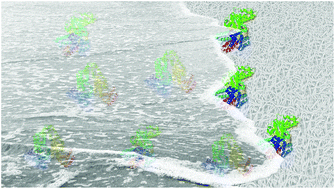Our official English website, www.x-mol.net, welcomes your feedback! (Note: you will need to create a separate account there.)
Addressing the distribution of proteins spotted on μPADs
Analyst ( IF 4.2 ) Pub Date : 2017-09-15 00:00:00 , DOI: 10.1039/c7an00849j Laura McCann 1, 2, 3, 4 , Tomás E. Benavidez 1, 2, 3, 4 , Sarah Holtsclaw 1, 2, 3, 4 , Carlos D. Garcia 1, 2, 3, 4
Analyst ( IF 4.2 ) Pub Date : 2017-09-15 00:00:00 , DOI: 10.1039/c7an00849j Laura McCann 1, 2, 3, 4 , Tomás E. Benavidez 1, 2, 3, 4 , Sarah Holtsclaw 1, 2, 3, 4 , Carlos D. Garcia 1, 2, 3, 4
Affiliation

|
Adsorption is the most common approach to immobilize biorecognition elements on the surface of paper-based devices. Adsorption is also the route selected to coat the substrate with albumin, therefore minimizing the interaction of other proteins. While similar in nature, the structure of the selected proteins as well as the conditions selected from the immobilization have a significant effect on the amount and distribution of the resulting composites. To illustrate these differences and provide general guidelines to efficiently prepare these devices, this article explores the interaction (adsorption and desorption) of BSA with 3MM chromatography paper. The experimental conditions investigated were the protein concentration, the interaction time, the number of times the protein was spotted, the pH of buffer solution, and the ionic strength of the buffer solution. The proposed approach mimics the steps involved in the fabrication (adsorption) and use (rinsing induced by the sample) of paper-based microfluidic devices. To identify the protein location following the rinsing step, the protein was fixed by dehydration in a convection oven and then stained using Coomassie Blue. The color intensity, which was found to be proportional to the amount of protein immobilized, was determined using a desktop scanner. To highlight the importance of understanding the adsorption process to the rational development of μPADs, results were complemented by experiments performed with lysozyme and immunoglobulin G.
中文翻译:

解决μPAD上斑点蛋白的分布
吸附是将生物识别元件固定在纸质设备表面的最常用方法。吸附也是选择用白蛋白包被底物的途径,因此使其他蛋白质的相互作用减至最小。尽管本质上相似,但所选蛋白质的结构以及从固定化中选择的条件对所得复合物的数量和分布都有重大影响。为了说明这些差异并提供有效准备这些设备的一般指导,本文探讨了BSA与3MM色谱纸的相互作用(吸附和解吸)。研究的实验条件为蛋白质浓度,相互作用时间,蛋白质被点样的次数,缓冲溶液的pH,和缓冲溶液的离子强度。拟议的方法模仿了纸基微流控设备的制造(吸附)和使用(由样品引起的漂洗)过程中涉及的步骤。为了确定漂洗步骤后的蛋白质位置,将蛋白质在对流烘箱中脱水固定,然后用考马斯亮蓝进行染色。使用台式扫描仪确定颜色强度,该颜色强度与固定的蛋白质量成正比。为了强调理解吸附过程对μPADs合理发育的重要性,对溶菌酶和免疫球蛋白G进行的实验对结果进行了补充。为了确定漂洗步骤后的蛋白质位置,将蛋白质在对流烘箱中脱水固定,然后用考马斯亮蓝进行染色。使用台式扫描仪确定颜色强度,该颜色强度与固定的蛋白质量成正比。为了强调理解吸附过程对μPADs合理发育的重要性,对溶菌酶和免疫球蛋白G进行的实验对结果进行了补充。为了确定漂洗步骤后的蛋白质位置,将蛋白质在对流烘箱中脱水固定,然后用考马斯亮蓝进行染色。使用台式扫描仪确定颜色强度,该颜色强度与固定的蛋白质量成正比。为了强调理解吸附过程对μPADs合理发育的重要性,对溶菌酶和免疫球蛋白G进行的实验对结果进行了补充。
更新日期:2017-09-15
中文翻译:

解决μPAD上斑点蛋白的分布
吸附是将生物识别元件固定在纸质设备表面的最常用方法。吸附也是选择用白蛋白包被底物的途径,因此使其他蛋白质的相互作用减至最小。尽管本质上相似,但所选蛋白质的结构以及从固定化中选择的条件对所得复合物的数量和分布都有重大影响。为了说明这些差异并提供有效准备这些设备的一般指导,本文探讨了BSA与3MM色谱纸的相互作用(吸附和解吸)。研究的实验条件为蛋白质浓度,相互作用时间,蛋白质被点样的次数,缓冲溶液的pH,和缓冲溶液的离子强度。拟议的方法模仿了纸基微流控设备的制造(吸附)和使用(由样品引起的漂洗)过程中涉及的步骤。为了确定漂洗步骤后的蛋白质位置,将蛋白质在对流烘箱中脱水固定,然后用考马斯亮蓝进行染色。使用台式扫描仪确定颜色强度,该颜色强度与固定的蛋白质量成正比。为了强调理解吸附过程对μPADs合理发育的重要性,对溶菌酶和免疫球蛋白G进行的实验对结果进行了补充。为了确定漂洗步骤后的蛋白质位置,将蛋白质在对流烘箱中脱水固定,然后用考马斯亮蓝进行染色。使用台式扫描仪确定颜色强度,该颜色强度与固定的蛋白质量成正比。为了强调理解吸附过程对μPADs合理发育的重要性,对溶菌酶和免疫球蛋白G进行的实验对结果进行了补充。为了确定漂洗步骤后的蛋白质位置,将蛋白质在对流烘箱中脱水固定,然后用考马斯亮蓝进行染色。使用台式扫描仪确定颜色强度,该颜色强度与固定的蛋白质量成正比。为了强调理解吸附过程对μPADs合理发育的重要性,对溶菌酶和免疫球蛋白G进行的实验对结果进行了补充。



























 京公网安备 11010802027423号
京公网安备 11010802027423号